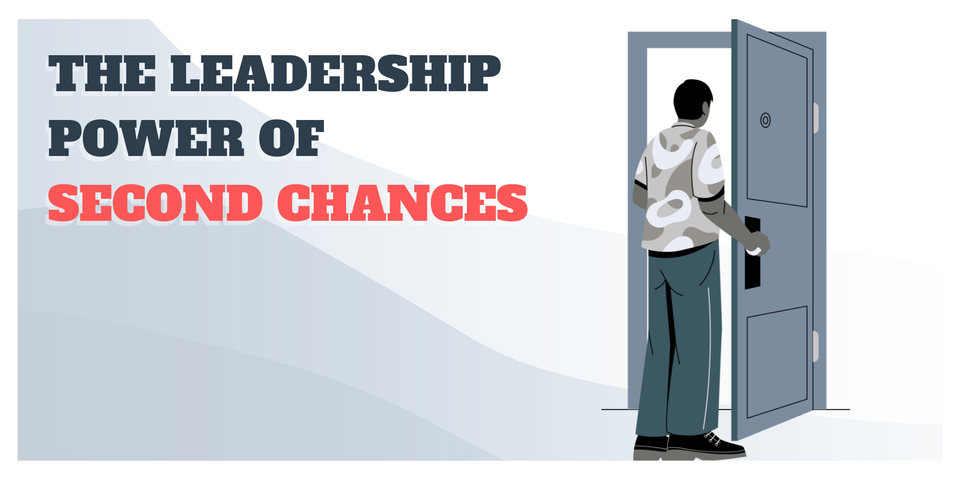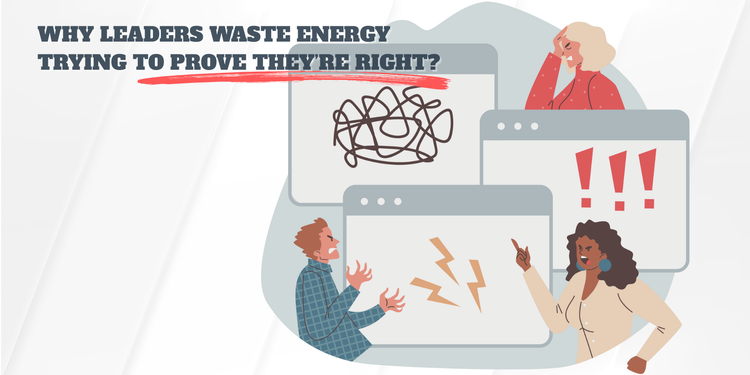The Leadership Power of Second Chances

A few years ago, I came very close to making a decision I would have regretted – letting someone go far too early.
On the surface, the case seemed simple. Deadlines were slipping, colleagues were whispering about his “attitude,” and I was under pressure from above to deliver results. In the moment, the narrative wrote itself: here was an engineer who wasn’t reliable, and keeping him around felt like a risk I couldn’t afford.
But something about that story didn’t sit right with me. I couldn’t quite put my finger on it, but I felt hesitation. Instead of rushing forward, I forced myself to slow down.
I started asking smaller questions, not the kind that put someone on the defensive, but ones that opened space for clarity. I listened more closely in one-on-ones, paying attention not just to what he said, but to how he said it. I watched for patterns between the lines – in his energy, in his workload, in the way others interacted with him.
Over the course of a few weeks, the truth began to surface. He wasn’t careless, and he wasn’t disengaged. What was really happening was almost invisible at first glance: he was covering for a teammate who had fallen behind, quietly carrying extra workload, and burning himself out without telling anyone.
That discovery shifted everything.
He didn’t suddenly become a stronger engineer after that. He already was one. What changed was me – my perspective, my willingness to give him a second chance, and my ability to see past the initial narrative.
Over time, he became one of the most dependable people on the team. Not because he transformed, but because he was finally seen for what he truly brought to the table.
Why Leaders Struggle with Second Chances
Second chances sound noble in theory, but in practice they are often the first thing leaders abandon when pressure rises. Deadlines loom, executives demand certainty, and suddenly the safest path feels like cutting losses quickly rather than slowing down to understand what’s really happening.
Part of the struggle comes from how our brains are wired. Under stress, we crave simple explanations – someone is either performing or they aren’t. We label people quickly: “lazy,” “difficult,” “not a team player.” These labels give us a sense of control in the moment, but they close the door to curiosity. Once a story takes hold, every piece of evidence gets filtered through it. A missed deadline becomes proof of laziness, a quiet meeting presence becomes evidence of disengagement. Confirmation bias does the rest.
There’s also a cultural layer. Many workplaces still operate under a perfectionist mindset: mistakes equal weakness, and weakness can’t be tolerated. Leaders grow up in systems where one failure can overshadow a hundred successes, so they carry that same zero-tolerance lens into their own management style.
The result is predictable but costly. Talented people get written off before they have a chance to recover. Trust is eroded when employees feel judged instead of understood. Teams lose not because individuals are incapable, but because leaders weren’t willing to pause long enough to see what was actually happening beneath the surface.
The Psychology of Second Chances
Our instinct to judge quickly isn’t just cultural – it’s biological. Under pressure, the brain looks for shortcuts. Psychologists call them cognitive biases: mental patterns that help us make fast decisions but often at the cost of accuracy.
One of the strongest at play is confirmation bias – once we form an impression of someone, we selectively notice evidence that supports it and filter out what doesn’t. A missed deadline becomes proof of laziness. A tense comment becomes proof of a “bad attitude.” The full picture never gets considered.
There’s also the role of stress and threat perception. Neuroscience shows that when leaders feel pressure, the brain’s amygdala (the threat center) becomes more active, while the prefrontal cortex (responsible for nuanced reasoning) takes a back seat. That makes us quicker to label and dismiss – we default to “fight or flight” judgments instead of deeper analysis.
On the other side, the science of motivation tells a different story. Research on psychological safety and growth mindset shows that people are far more likely to improve when they feel seen, supported, and trusted after mistakes. A second chance, handled well, doesn’t weaken accountability – it actually strengthens performance by reinforcing trust and engagement.
In other words: the instinct to cut fast and move on is human. But the ability to pause, reframe, and create space for growth is what separates reactive managers from emotionally intelligent leaders.
The EQ Perspective on Second Chances
What ultimately turns a second chance into a success isn’t luck. It’s emotional intelligence. EQ gives leaders the tools to pause, reframe, and look deeper before making a judgment they might later regret.
- Self-awareness is the starting point. Leaders need to notice when their decisions are being shaped more by stress, pressure, or ego than by objective reality. The instinct to protect performance at all costs can easily blur into snap judgments that aren’t fair or accurate.
- Empathy pushes you to look for the story behind the behavior. Missed deadlines, abrupt communication, or visible frustration are often symptoms, not causes. When you get curious instead of critical, you uncover what’s driving the surface behavior – whether it’s hidden workload, personal stress, or unclear expectations.
- Perspective helps you flip the script. If you were in their shoes, under the same conditions, what would you want from your leader? Judgment – or understanding? A closed door – or the space to recover and prove yourself? This simple reversal grounds decisions in humanity rather than assumption.
- Adaptability is what prevents second chances from becoming empty gestures. It means being willing to update your view when new information surfaces. It means acknowledging that your first impression may have been incomplete. And it means creating conditions where someone can grow without being permanently defined by one mistake.
Leaders who practice these four qualities don’t give out endless passes or ignore real performance issues. Instead, they create the space where people can be fairly seen – and where some of the best talent reveals itself only after that second chance.
The 4 Pillars of Second-Chance Leadership
Second chances are powerful – but they aren’t about blind optimism or endless forgiveness. They work when leaders provide structure around them. These four pillars make the difference between a wasted opportunity and a transformative one.
1. Clarity
Most second chances fail because expectations were never clear in the first place. If someone doesn’t know what success looks like, how can they meet it? Leaders must reset the table: define what’s expected, why it matters, and how progress will be measured. Without clarity, a second chance is just a vague hope.
2. Curiosity
Before assuming intent, ask questions. Why did this happen? What obstacles might be hidden? Was the issue skill, workload, or communication? Curiosity uncovers what the surface never reveals, and often shows you the problem wasn’t the person, but the circumstances around them.
3. Compassion
Second chances are ultimately about humanity. People make mistakes, fall behind, or carry invisible burdens. Compassion doesn’t mean lowering the bar – it means recognizing effort, intent, and context before writing someone off. When people feel understood, they respond with loyalty and growth.
4. Conditions
A second chance isn’t a blank check. It’s a defined opportunity. Leaders should be transparent: “Here’s the improvement we need to see, and here’s how we’ll support you.” Boundaries matter. They keep the process fair and sustainable – for both the person and the team.
Together, these four pillars create a framework where second chances are not about being soft, but about being smart. They give people the opportunity to grow while keeping standards intact – a balance that turns potential missteps into moments of breakthrough.
Practical Tips for Leaders
Turning the idea of second chances into action requires small but deliberate habits. Here are practical ways to lead with EQ when someone stumbles:
- Pause before deciding – Don’t make termination or reassignment decisions in the heat of stress. Give yourself a window to reflect.
- Ask into behavior – Instead of assuming intent (“lazy,” “unreliable”), ask: “What’s behind this delay?” or “What’s making this difficult right now?”
- Look for hidden blockers – Workload imbalances, personal struggles, or unclear expectations often drive what looks like poor performance.
- Revisit expectations – Reset what success looks like with clarity and mutual understanding.
- Check progress visibly – After granting a second chance, observe whether performance and engagement actually shift. This protects the team while giving space to improve.
- Be transparent – Share your perspective: “I want to give you another shot because I believe there’s more here than what I’ve seen so far.” That honesty builds trust and motivation.
Final Word
Second chances are not a sign of weakness. They are a mark of wisdom.
It takes very little effort to judge quickly, label harshly, and move on. It takes far more skill – and far more courage – to pause, look deeper, and see the whole person before making a call.
Some of the most talented people you’ll ever work with will not shine on the first try. They’ll stumble under hidden workload, miscommunication, or the weight of circumstances you can’t see at first glance. But when given the space of a second chance – with clarity, curiosity, compassion, and clear conditions – they rise.
Not because they suddenly became different. But because they were finally seen.
That is the quiet power of emotionally intelligent leadership: creating the conditions where people are not defined by a single mistake, but by their capacity to grow when someone believes in them.
More Ways I Can Support You?
Work With Me 1:1 – Fast-Track Your Leadership Growth!
If you're serious about accelerating your career and becoming the kind of leader people respect and follow, I offer premium 1:1 coaching tailored to your needs. My coaching focuses on:
👥 Build stronger stakeholder relationships!
🗣️ Increase your confidence and influence!
📊 Have higher retention and engagement!
🕊️ Become a smooth conflict resolver!
🚀 Improve your team’s performance!
🌟 Build your leadership reputation!
🎯 Get promoted a lot faster!
🧘 Avoid burnout and stress!
This isn’t just theory, it’s actionable, personalized coaching based on real-world leadership experience.
Let’s Build Emotionally Intelligent Leaders, Together
I’d love to hear from you:
What’s the biggest leadership challenge you’re facing right now?
Hit reply and let me know. I read every response.
If this resonates with you, share this newsletter with a friend or colleague who could benefit from it.
You can also follow me on LinkedIn for more real-world leadership insights.
Let’s build the future of leadership one insight at a time!
Thanks for reading all the way through!
– Djordje
Founder, The Chronicles of a High-EQ Leader.





Member discussion